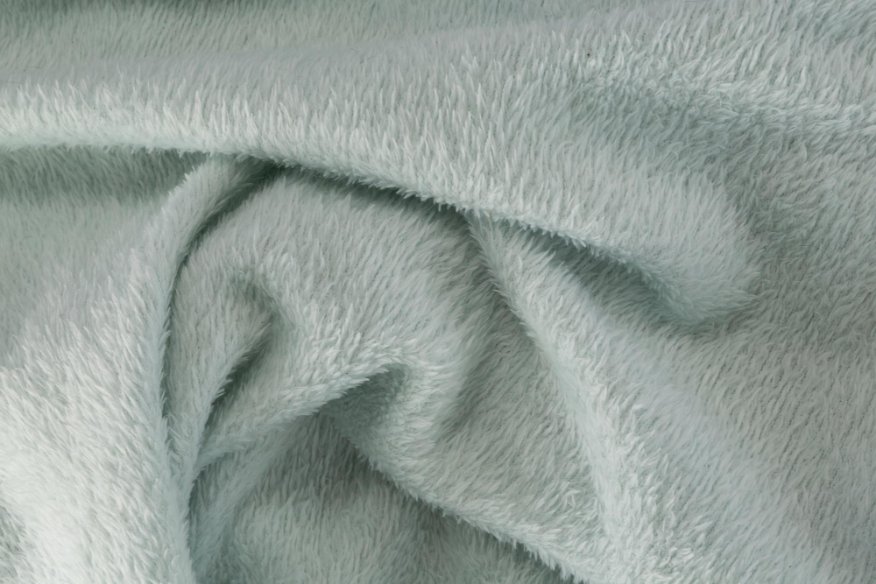Your go-to resource for understanding fleece fabric, from types and benefits to care instructions and buying tips
Quick Takeaways
- Fleece is a synthetic fabric made primarily from polyester that provides warmth without bulk
- It comes in different weights (100-300+ GSM) for various activities and weather conditions
- Fleece is moisture-wicking, quick-drying, and easier to care for than wool
- Available in both traditional and eco-friendly recycled versions
- Works well for layering systems, activewear, and everyday casual wear
- Proper care extends its lifespan while minimizing environmental impact from microfiber shedding
Table of Contents
- What is Fleece Fabric?
- History and Development
- How Fleece is Made
- Types of Fleece Fabric
- Fleece vs Other Fabrics
- Benefits of Fleece
- Drawbacks and Limitations
- How to Care for Fleece
- Buying Guide: Choosing the Right Fleece
- Environmental Impact and Sustainability
- Top Fleece Brands Compared
- Styling and Layering Tips
- Working with Fleece: DIY and Sewing Tips
- Frequently Asked Questions
- Conclusion
What is Fleece Fabric?
Fleece is a soft, warm synthetic fabric designed to mimic the insulating properties of wool without the weight, itch, or water-retention problems. When you touch fleece, you’ll notice it has a fuzzy, plush texture that feels cozy against your skin. The fabric traps warm air in thousands of tiny pockets, keeping you comfortable in cold weather.
Most fleece today is made from polyester fibers, though you can also find cotton blends and even versions made from recycled plastic bottles. Unlike natural fleece (which refers to wool from sheep), synthetic fleece is specifically engineered for performance, breathability, and easy care.
Is fleece 100% cotton? No, traditional fleece is not cotton. Most fleece is 100% polyester or a polyester blend. However, there are cotton fleece fabrics available, which have a smooth outer surface and a brushed inner layer. These cotton versions feel different from synthetic fleece and don’t have the same moisture-wicking properties.
History and Development
Fleece was born in the late 1970s when Malden Mills (now Polartec) set out to create a lightweight alternative to wool. Working with Patagonia founder Yvon Chouinard, they developed what we now call polar fleece in 1981. The goal was simple: create a fabric that kept outdoor enthusiasts warm and dry without adding bulk or requiring the high maintenance of wool.
The result changed outdoor apparel forever. Fleece quickly moved from hiking trails to everyday wardrobes, becoming one of the most popular fabrics for winter clothing. Time Magazine even named it one of the 100 most important inventions of the 20th century in 1999.
How Fleece is Made
Understanding how fleece is made helps you appreciate why it performs so well:
- Polymerization: Plastic pellets (usually polyethylene terephthalate or PET) are melted into a liquid
- Extrusion: The liquid is forced through tiny holes in a spinneret, creating fine threads as it cools
- Knitting: These threads are woven into a lightweight fabric base
- Brushing: The fabric surface is mechanically brushed to create the characteristic fuzzy texture that traps air
- Finishing: Additional treatments may be applied for water resistance, anti-pilling, or other properties
Modern eco-friendly versions follow the same process but start with recycled plastic bottles instead of virgin petroleum products. You can learn more about how polyester is manufactured for deeper technical details.
Types of Fleece Fabric
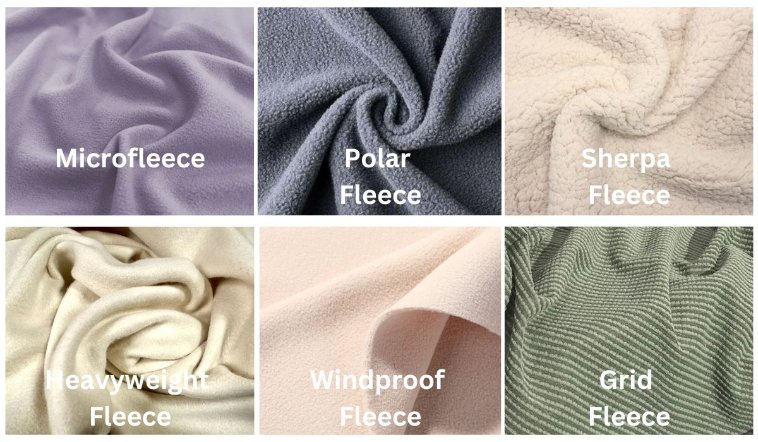
Not all fleece is created equal. You’ll find different types designed for specific uses, temperatures, and activities. Here’s what you need to know about each type:
Microfleece (Lightweight)
Microfleece is the thinnest option, typically weighing between 100-200 grams per square meter (GSM). If you’re looking for a base layer or something for mild weather, this is your fabric. It’s incredibly soft, highly breathable, and fits snugly under other layers without adding bulk. You’ll love it for high-output activities like running or as a comfortable travel layer.
Best for: Base layers, spring/fall weather, active sports, traveling light
Polar Fleece (Mid-Weight)
This is the most common type you’ll encounter. Polar fleece weighs 200-300 GSM and strikes the perfect balance between warmth and mobility. It’s thick enough to keep you comfortable on cool days but not so heavy that you’ll overheat during moderate activity. You can wear it as a standalone jacket or as part of a winter layering system.
Best for: General outdoor use, casual wear, layering, everyday jackets
Heavyweight Fleece
When temperatures really drop, heavyweight fleece (300+ GSM) delivers serious warmth. This thicker option provides more insulation but reduces breathability. You’ll appreciate it for standing around in cold weather or as an insulating layer under a waterproof shell during winter activities.
Best for: Very cold weather, low-activity situations, winter camping, arctic conditions
Sherpa Fleece
Sherpa fleece mimics the look and feel of sheepskin with its textured, woolly surface. One side usually has a smooth knit while the other features that distinctive fluffy pile. It’s incredibly cozy and trendy right now, making it perfect for loungewear and casual jackets. However, it’s bulkier and less packable than traditional fleece.
Best for: Loungewear, fashion pieces, blankets, jacket linings
Grid Fleece (Technical)
Grid fleece features a waffle-like pattern on the inside that maximizes breathability while maintaining warmth. The raised squares create more surface area for moisture to evaporate, making it excellent for high-intensity activities. You’ll pay more for this technical option, but if you run hot or engage in aerobic winter activities, it’s worth it.
Best for: Ski touring, winter running, mountaineering, high-output activities
Windproof Fleece
Some fleece fabrics include a windproof membrane or tighter knit construction. Polartec Wind Pro is a popular example. These fabrics block up to 95% of wind while maintaining breathability. The trade-off is slightly reduced breathability compared to standard fleece.
Best for: Windy conditions, exposed ridges, cycling, sailing
Fleece Types Comparison
| Type | Weight (GSM) | Warmth | Breathability | Best Use | Price Range |
|---|---|---|---|---|---|
| Microfleece | 100-200 | Low-Medium | Excellent | Base layers, active wear | $ |
| Polar Fleece | 200-300 | Medium-High | Good | General use, layering | $$ |
| Heavyweight | 300+ | High | Moderate | Cold weather, outer layer | $$$ |
| Sherpa | 250-350 | High | Low | Casual wear, loungewear | $$ |
| Grid Fleece | 180-280 | Medium | Excellent | High-intensity activities | $$$ |
| Windproof | 250-300 | Medium-High | Good | Windy conditions | $$$$ |
Not sure which type you need? Try our Winter Fabric Selector Quiz to get personalized recommendations based on your climate, activities, and preferences.
Fleece vs Other Fabrics
How does fleece stack up against other popular fabrics? Let’s break down the key differences so you can make informed decisions about your wardrobe.
Fleece vs Cotton
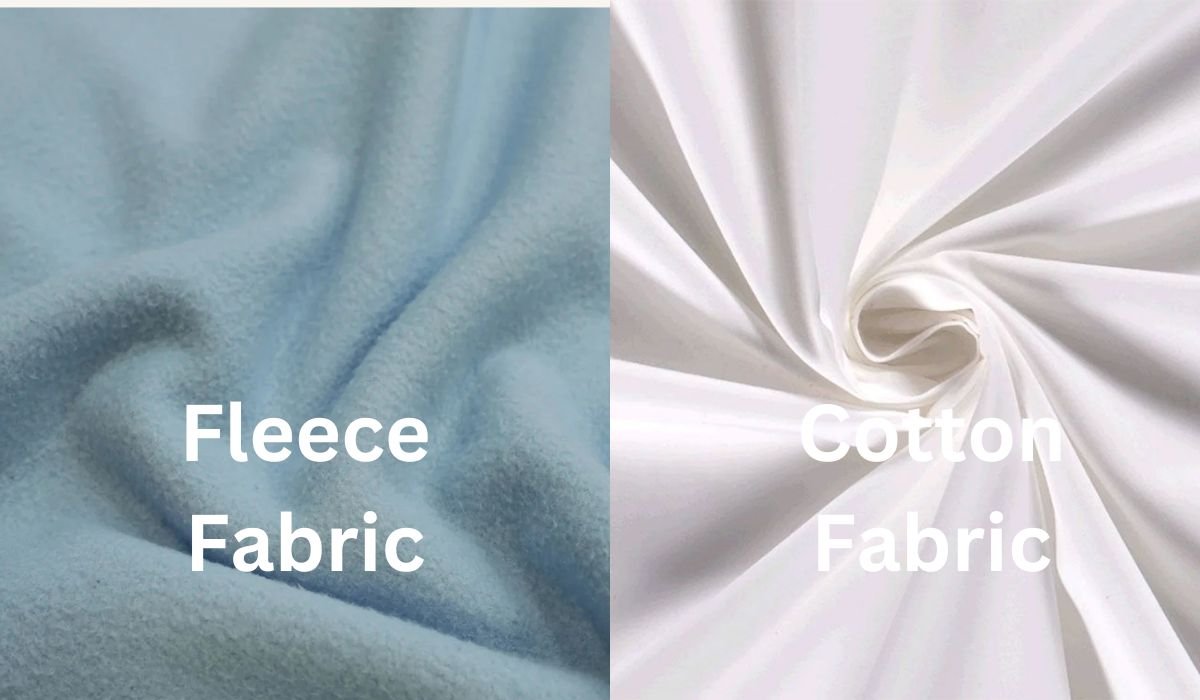
This is one of the most common questions people ask. The answer depends on what you need the fabric to do:
Fleece wins for warmth, moisture management, and quick drying. When you’re active and sweating, fleece wicks moisture away from your skin and dries in a fraction of the time cotton needs. It also maintains its insulating properties when damp, unlike cotton which becomes cold and heavy when wet.
Cotton, on the other hand, is more breathable in hot weather, feels softer against bare skin for many people, and is completely natural if you’re avoiding synthetic materials. Cotton fleece (French Terry) offers a middle ground with some warmth but better moisture absorption for activities like yoga or gym workouts.
Choose fleece if: You need warmth, moisture-wicking, quick drying, or low-maintenance care
Choose cotton if: You want breathability in warm weather, natural fibers, or softer feel against skin
For a detailed comparison, check out our cotton vs polyester guide or use our interactive comparison tool.
Fleece vs Wool
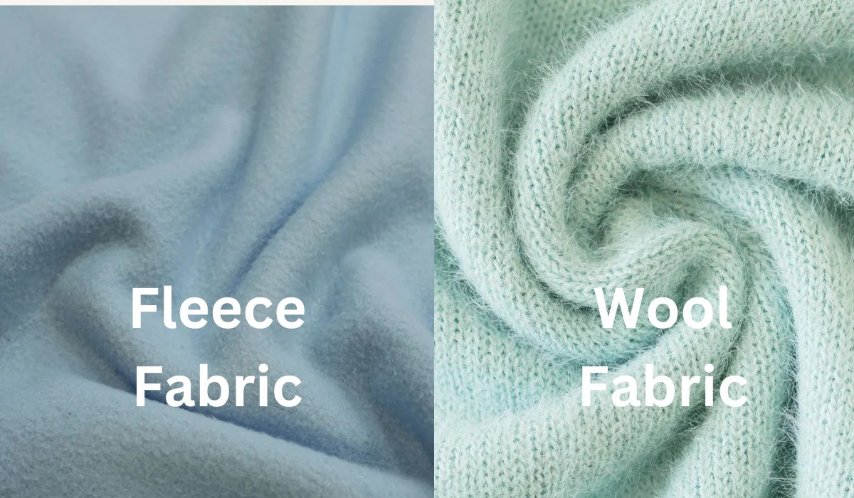
Wool has been the traditional cold-weather fabric for centuries. So is fleece just as warm as wool? The answer is yes, but with important differences in how they achieve that warmth.
Both fabrics trap air to provide insulation, but wool absorbs moisture (up to 30% of its weight) while fleece repels it. This means wool can feel damp and heavy, especially in wet conditions, while fleece stays light and dries quickly. Wool also requires more careful maintenance, special detergents, and can’t typically go in the dryer.
However, wool has natural odor resistance that fleece lacks. After a few days of wear, your fleece jacket will smell noticeably worse than a merino wool layer. Wool is also naturally flame-resistant and biodegradable.
| Feature | Fleece | Wool |
|---|---|---|
| Warmth when dry | Excellent | Excellent |
| Warmth when wet | Good | Fair |
| Weight | Lightweight | Heavy |
| Drying time | Very fast | Slow |
| Odor resistance | Poor | Excellent |
| Care requirements | Machine washable | Hand wash/gentle care |
| Durability | 50+ washes | Delicate, can felt |
| Environmental impact | Microplastics | Biodegradable |
| Price | $20-$150 | $50-$300+ |
Choose fleece if: You need easy care, light weight, quick drying, or budget-friendly warmth
Choose wool if: You want natural fibers, odor resistance, or plan to wear the same layer for multiple days
Is Fleece Better Than Polyester?
This question confuses people because fleece IS polyester. More specifically, fleece is a type of polyester fabric with a brushed surface. When people ask this question, they usually mean: “Is fleece better than smooth polyester fabrics?”
The brushed structure of fleece makes it warmer and softer than smooth polyester fabrics. Regular polyester athletic wear is designed for cooling and moisture-wicking during activity, while fleece is designed for insulation and warmth. Both serve different purposes in your wardrobe.
Benefits of Fleece Fabric
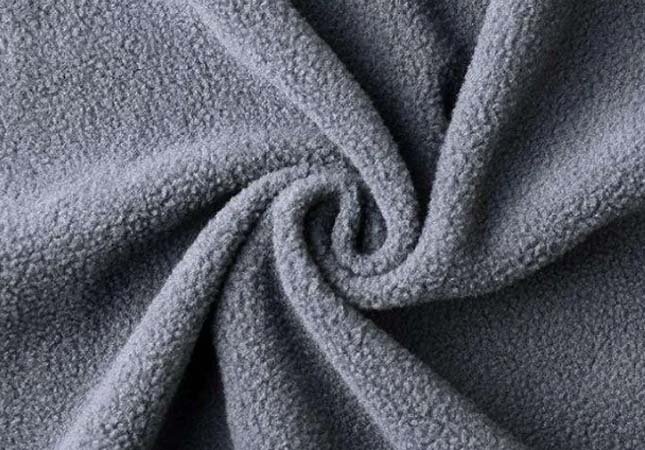
Why has fleece become so popular? Here are the key benefits that make it a go-to fabric for millions of people:
Warmth Without Weight
Fleece delivers exceptional warmth-to-weight ratio. You can stay comfortable in cold weather without feeling weighed down by heavy layers. A 200-weight fleece jacket typically weighs less than a pound but provides warmth comparable to much heavier materials.
Moisture-Wicking Performance
When you’re active and sweating, fleece pulls moisture away from your skin and moves it to the fabric’s outer surface where it can evaporate. This keeps you dry and prevents that clammy feeling you get with absorbent fabrics like cotton. Even if the fabric gets damp, it continues to insulate.
Quick-Drying
Drop your fleece jacket in a stream while hiking? No problem. It’ll be dry in an hour or two of wearing it. Machine wash it in the morning? It’ll be ready to wear by afternoon. This fast-drying property makes fleece incredibly practical for travel and active lifestyles.
Easy Care and Maintenance
You can throw most fleece in the washing machine with your regular laundry and air dry it. No special detergents, no dry cleaning, no complicated care routines. It doesn’t shrink, fade minimally, and maintains its performance through countless washes. For busy people, this convenience is a game-changer.
Durability
Quality fleece can last for years of regular use. It resists tears, doesn’t easily snag, and the synthetic fibers don’t break down quickly like natural materials. Anti-pill treatments on modern fleece keep it looking good even after 50+ washes. You’re making a solid investment when you buy well-made fleece.
Breathability
Unlike waterproof shells that trap heat, fleece allows air to circulate. This prevents overheating during activity while still maintaining warmth when you’re at rest. The breathability makes it comfortable across a wider range of temperatures and activity levels.
Versatility
Fleece works as a standalone outer layer in cool weather, a mid-layer when it’s really cold, or a base layer for extreme conditions. You can wear it for outdoor adventures, casual errands, working from home, or even dressier occasions (looking at you, fleece blazers). Few fabrics adapt to so many different uses.
Affordability
Compared to down jackets, wool sweaters, or technical softshells, fleece offers warmth at a much more accessible price point. You can find quality fleece jackets starting around $30-50, while high-end options rarely exceed $150. This makes it easy to outfit your whole family.
Good for Sensitive Skin
If wool makes you itch, fleece is your friend. The smooth synthetic fibers don’t have the scales that cause irritation with wool. Most people find fleece comfortable against bare skin, though those with very sensitive skin should look for high-quality options without rough seams or harsh dyes.
Drawbacks and Limitations of Fleece
Fleece isn’t perfect. Understanding its limitations helps you use it appropriately and make better purchasing decisions.
What Fleece Does Well
- Provides excellent warmth for weight
- Dries incredibly fast
- Machine washable and low maintenance
- Stays warm even when damp
- Durable and long-lasting
- Affordable compared to alternatives
- Soft and comfortable
- Doesn’t restrict movement
Where Fleece Falls Short
- Not wind resistant (unless treated)
- No water resistance
- Collects odors quickly
- Pills over time (without treatment)
- Attracts lint and pet hair
- Generates static electricity
- Sheds microplastics when washed
- Can be too warm for summer
- Not suitable for formal wear
Environmental Concerns
The biggest downside of fleece is its environmental impact. Every time you wash fleece, it sheds thousands of microplastic fibers that end up in waterways. These microfibers have been found everywhere from Arctic ice to deep ocean trenches, and inside marine animals and even human bodies.
While recycled polyester fleece is better than virgin polyester (using 59% less energy to produce), it still sheds microplastics. The shedding is worst during the first few washes, then decreases over time. You can minimize this issue by:
- Using a Guppyfriend washing bag or Cora Ball to catch microfibers
- Washing fleece less frequently (spot clean when possible)
- Choosing front-load washers over top-load (generates less friction)
- Using liquid detergent instead of powder
- Washing in cold water with shorter cycles
- Keeping fleece garments in use as long as possible
Not Water Resistant
Standard fleece offers zero protection from rain or snow. Water soaks right through it. While fleece maintains some insulating ability when wet, you’ll be cold and uncomfortable in precipitation. You need to layer it under a waterproof shell for wet conditions, which adds bulk and cost.
Limited Wind Protection
The open structure that makes fleece breathable also lets wind blow right through it. On a windy day, you’ll lose heat quickly unless you add a windproof layer. This is why you rarely see people wearing only fleece on exposed mountain ridges or while cycling.
Odor Retention
Synthetic fabrics hold onto body odor much more than natural fibers like wool or cotton. After a few days of wear (or even one sweaty workout), your fleece will start to smell. This makes it less ideal for multi-day trips where washing isn’t an option.
Pilling
Without anti-pill treatment, fleece develops little balls of fiber on its surface from friction and washing. This doesn’t affect performance but makes it look worn and shabby. Quality fleece with anti-pill treatment minimizes this issue but doesn’t eliminate it completely.
How to Care for Fleece Fabric
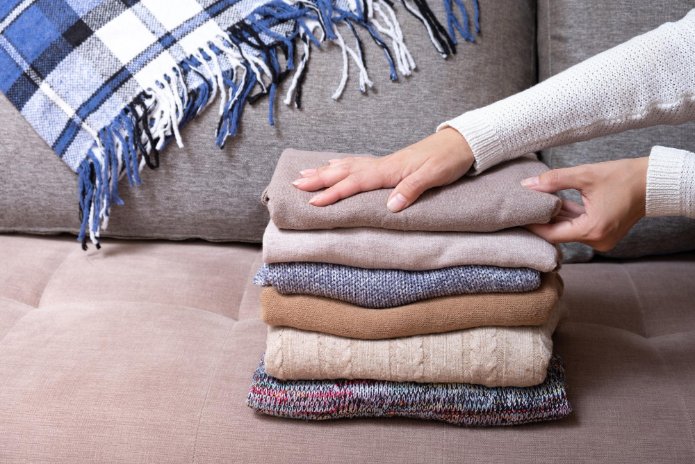
Proper care extends the life of your fleece and maintains its performance. The good news? Fleece is one of the easiest fabrics to maintain. Here’s everything you need to know:
Washing Fleece
You can put fleece in a washing machine, but follow these guidelines for best results:
- Turn garments inside out to protect the outer surface from abrasion
- Use cold water (30°C/86°F or below) to prevent damage and reduce microfiber shedding
- Choose gentle or delicate cycle to minimize friction
- Use mild liquid detergent – avoid powder detergents which can be harsh
- Skip fabric softener completely – it coats fibers and reduces moisture-wicking ability
- Don’t use bleach unless you want to damage your fleece
- Wash with similar colors to prevent dye transfer
- Don’t overload the machine – fleece needs room to move freely
Important: Fabric softener is fleece’s enemy. It leaves a coating that blocks moisture-wicking pores and reduces the fabric’s ability to trap warm air. Once you’ve used fabric softener on fleece, the damage is often permanent.
Drying Fleece
The best way to dry fleece is air drying. Hang it up or lay it flat, and it’ll be dry in a few hours thanks to fleece’s quick-drying properties. This method prevents pilling, maintains the fabric’s loft, and saves energy.
If you must use a dryer:
- Use the lowest heat setting (or no heat/air dry if available)
- Remove promptly when dry to prevent unnecessary heat exposure
- High heat can melt or damage polyester fibers
- Dryer sheets are fine but not necessary (avoid if you want maximum moisture-wicking)
Can Fleece Be Ironed?
You should avoid ironing fleece. The synthetic fibers can melt under high heat, permanently damaging your garment. If your fleece is wrinkled (which is rare since it’s knit and naturally resists wrinkles), either:
- Hang it up and let wrinkles fall out naturally
- Use a steamer on the lowest setting, held away from the fabric
- If you must iron, use the absolute lowest temperature, place a thin cloth between the iron and fleece, and test on an inconspicuous area first
Removing Pills and Refreshing Fleece
Over time, even anti-pill fleece may develop some pilling. Here’s how to refresh it:
- Use a fabric shaver or de-pilling comb (available for $10-20)
- Gently run the tool over pilled areas in one direction
- For stubborn pills, carefully cut them off with small scissors
- A disposable razor works in a pinch (use carefully to avoid cuts)
Stain Removal
Fleece is relatively stain-resistant, but accidents happen:
- Treat stains immediately for best results
- Blot (don’t rub) liquid stains with a clean cloth
- For grease: Apply dish soap directly to the stain, let sit 10 minutes, then wash
- For dirt: Let it dry, brush off what you can, then spot clean or wash
- For tough stains: Pre-treat with a stain remover before washing
Storage
Store fleece properly to keep it in top condition:
- Clean before storing to prevent set-in stains or odors
- Fold rather than hang to maintain shape (hanging can cause shoulders to stretch)
- Store in a cool, dry place away from direct sunlight
- Avoid compression for long periods – let the fabric breathe
- Use cedar blocks or lavender sachets to deter moths (though they don’t eat synthetic fibers, they might nest in them)
How Often Should You Wash Fleece?
You don’t need to wash fleece after every wear. In fact, washing less frequently extends its life and reduces environmental impact. Wash when:
- It’s visibly dirty
- It smells (even after airing out)
- You’ve been sweating heavily in it
- Every 3-5 wears for casual use
- After each wear for intense activities
Between washes, air out your fleece by hanging it outside or in a well-ventilated area. This removes odors without the environmental cost of washing.
For more detailed care instructions for synthetic fabrics, check out our complete synthetic fabric care guide or use our Fabric Care Generator for personalized recommendations.
Buying Guide: Choosing the Right Fleece
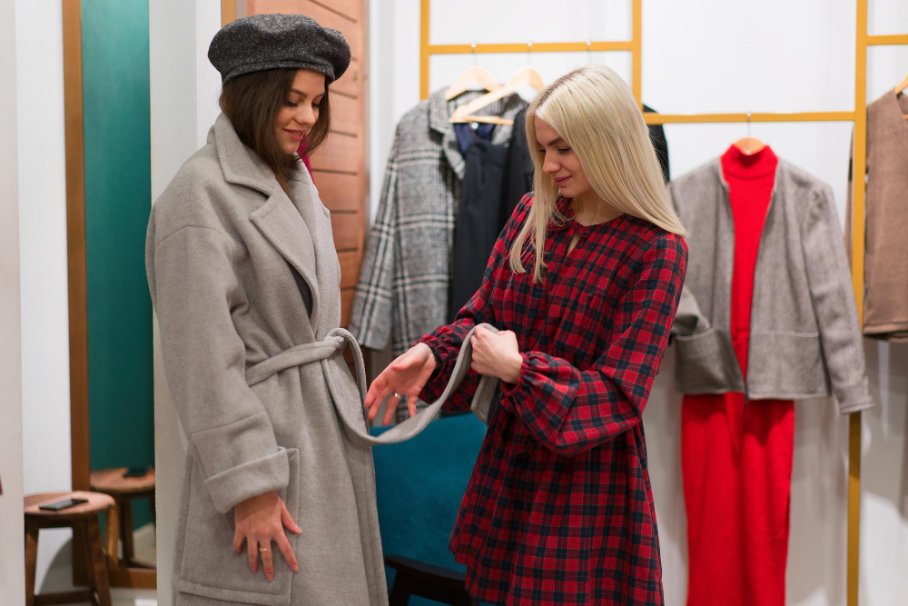
Walking into a store (or browsing online) and seeing dozens of fleece options can be overwhelming. Here’s how to choose the right one for your needs:
Consider Your Primary Use
For High-Output Activities (Running, Ski Touring, Climbing):
Look for: Microfleece or grid fleece, 100-200 GSM
Why: Maximum breathability prevents overheating when you’re working hard
For General Outdoor Use (Hiking, Camping, Daily Wear):
Look for: Polar fleece, 200-300 GSM
Why: Best balance of warmth, versatility, and breathability for varied conditions
For Cold Weather Standing Around (Spectating, Photography, Fishing):
Look for: Heavyweight fleece, 300+ GSM
Why: Maximum insulation when you’re not generating body heat
For Layering Under Shells:
Look for: Slim-fit microfleece or polar fleece
Why: Reduces bulk and allows freedom of movement under outer layers
For Windy Conditions:
Look for: Windproof fleece with membrane or tight knit
Why: Blocks wind chill while maintaining breathability
Weight and Warmth Guidelines
| Weight | Temperature Range | Activity Level | Typical Use |
|---|---|---|---|
| 100 GSM | 10-20°C (50-68°F) | High output | Base layer, spring/fall |
| 200 GSM | 0-15°C (32-59°F) | Moderate activity | Mid-layer, cool weather |
| 300 GSM | -10 to 5°C (14-41°F) | Low activity | Outer layer, winter |
| 300+ GSM | Below -10°C (14°F) | Stationary | Arctic conditions |
Note: These are general guidelines. Your personal temperature regulation, wind conditions, and whether you’re wearing additional layers all affect actual comfort ranges.
Important Features to Look For
Anti-Pill Treatment: Essential for maintaining appearance after multiple washes. Look for labels mentioning “anti-pill” or “no-pill” finish.
Full Zip vs. Quarter Zip vs. Pullover:
- Full zip: Maximum versatility for temperature regulation, easier to take on/off
- Quarter zip: Good ventilation, less bulk, better wind protection at neck
- Pullover: Warmest (no zipper draft), lightest, most affordable
Hood or No Hood? A hood adds versatility and warmth without much weight, but can bunch up under a waterproof jacket. If you often wear fleece under shells, skip the hood.
Pockets: Consider pocket placement:
- Hand pockets: Standard warmth, but inaccessible with a harness or backpack hip belt
- Chest pockets: Accessible with gear on, good for small items
- Internal pockets: Security for valuables, phone protection from cold
Fit Considerations:
- Slim fit: Better for layering under shells, more flattering, less fabric bulk
- Regular fit: Room for base layers underneath, comfortable for all-day wear
- Relaxed fit: Maximum layering room, most comfortable, casual style
Reinforcements: Higher-quality fleece often includes:
- Reinforced shoulders and elbows for durability with backpack straps
- Nylon panels in high-wear areas
- Binding at cuffs and hem to prevent stretching
Recycled vs. Virgin Polyester
More brands now offer fleece made from recycled plastic bottles. Recycled polyester fleece uses 59% less energy to produce and keeps plastic out of landfills. Performance-wise, you won’t notice a difference. The main consideration is price – recycled fleece sometimes costs $10-30 more, though the gap is narrowing as production scales up.
Price vs. Quality
What’s the difference between cheap and expensive fleece? Several things:
Budget Fleece ($20-40):
- Often thinner and less durable
- May pill more quickly without anti-pill treatment
- Simpler construction with fewer features
- Suitable for occasional use or kids who’ll outgrow it
- Good value if you’re on a tight budget
Mid-Range Fleece ($50-100):
- Anti-pill treatment standard
- Better construction with reinforced high-wear areas
- More thoughtful features (thumb holes, interior pockets, etc.)
- Better fit and finish
- Sweet spot for most people
Premium Fleece ($100-200+):
- Technical fabrics like Polartec Power Grid or Wind Pro
- Excellent durability and construction
- Advanced features (DWR coating, articulated sleeves, etc.)
- Brand names like Patagonia, Arc’teryx, Outdoor Research
- Worth it if you use it frequently or need specific technical features
When Is Fleece Too Warm?
Is fleece too hot for summer? Yes, for most people in warm weather. Fleece is designed for insulation, making it uncomfortable when temperatures are above 20°C (68°F). However, lightweight microfleece can work for cool summer evenings or air-conditioned indoor spaces.
For summer activities, you’re better off with summer-appropriate fabrics like lightweight cotton, linen, or moisture-wicking synthetics designed for cooling rather than insulating.
Still not sure what to buy? Try our interactive Fabric Identification Quiz to learn more about different fabric options for your needs.
Environmental Impact and Sustainability
Let’s be honest about fleece’s environmental footprint. As much as we love its performance, it comes with real environmental costs that you should understand.
The Microplastic Problem
Every time you wash fleece, it releases thousands of microscopic plastic fibers into the water system. Studies show a single fleece jacket can shed up to 1.7 grams of microfibers per wash – roughly equivalent to 1,174,000 individual fibers. These microplastics:
- Pass through water treatment plants (they’re too small to filter)
- End up in oceans, rivers, and soil
- Are consumed by fish and other marine life
- Enter the human food chain
- Have been found in remote areas from Arctic ice to mountain peaks
- Never fully break down (they just get smaller)
The first 5-10 washes are the worst for shedding. After that, the rate decreases significantly but never stops completely. Cheaper, lower-quality fleece sheds more than well-made versions.
Solutions to Reduce Microplastic Shedding
You can dramatically reduce the microplastic problem with these strategies:
1. Use a Microfiber Catching Device:
- Guppyfriend Washing Bag: A zippered mesh bag that catches fibers during washing (reduces shedding by 86%)
- Cora Ball: A ball you toss in with your laundry that collects fibers ($30-40)
- External filters: Some washing machine filters specifically target microplastics
2. Wash Less Frequently: The biggest impact you can make is simply washing your fleece less often. Air it out between wears, spot-clean small stains, and only wash when truly needed.
3. Choose Quality Over Quantity: Better-made fleece with tighter construction sheds fewer fibers. Buying one high-quality piece that lasts 10 years is better than buying three cheap ones that you replace every few years.
4. Keep Fleece in Use Longer: The longer you use a fleece garment, the more you amortize its environmental impact. Repair small tears, remove pills to keep it looking good, and pass it on when you’re done with it.
Recycled Polyester: A Better Choice?
Recycled polyester fleece addresses some environmental concerns but not all:
Benefits:
- Diverts plastic bottles from landfills (about 25 bottles per jacket)
- Uses 59% less energy than virgin polyester production
- Reduces petroleum extraction
- Lowers carbon emissions by 32%
- Performs identically to virgin polyester
Limitations:
- Still sheds microplastics when washed
- Recycling process still requires energy
- Often mixed with virgin polyester (not 100% recycled)
- Eventually becomes waste itself (though some brands have take-back programs)
Major brands like Patagonia, The North Face, and REI now offer extensive recycled fleece collections. While not perfect, choosing recycled options is a step in the right direction.
Natural Alternatives
If you want to avoid synthetic fleece entirely, consider these alternatives:
Wool (Merino or Regular): Natural, biodegradable, excellent temperature regulation, naturally odor-resistant. Heavier, more expensive, requires more care.
Cotton Fleece (French Terry): Natural fiber, soft, breathable. Less warm, absorbs moisture, heavier when wet.
Hemp/Cotton Blends: Sustainable, durable, breathable. Limited warmth, not widely available in fleece-like construction.
The reality is that no synthetic currently matches fleece’s performance for lightweight warmth while being fully natural. The closest is wool, but it comes with its own drawbacks.
End-of-Life Considerations
When your fleece is truly worn out:
- Donate if wearable: Many organizations accept used fleece
- Brand take-back programs: Patagonia, The North Face, and others will recycle old garments
- Textile recycling: Find a local textile recycling center (don’t throw in regular recycling)
- Upcycle: Turn old fleece into pet beds, cleaning rags, or craft projects
- Last resort: Regular trash (fleece in landfills doesn’t break down but also doesn’t shed microplastics into water)
The Bottom Line on Sustainability
Fleece has environmental costs, primarily from microplastic shedding. The most sustainable approach is to:
- Buy less and choose quality pieces that last
- Opt for recycled polyester when possible
- Use a microfiber-catching device when washing
- Wash only when necessary
- Keep garments in use as long as possible
- Properly recycle at end of life
No clothing choice is perfectly sustainable, but informed decisions reduce your impact.
Top Fleece Brands Compared
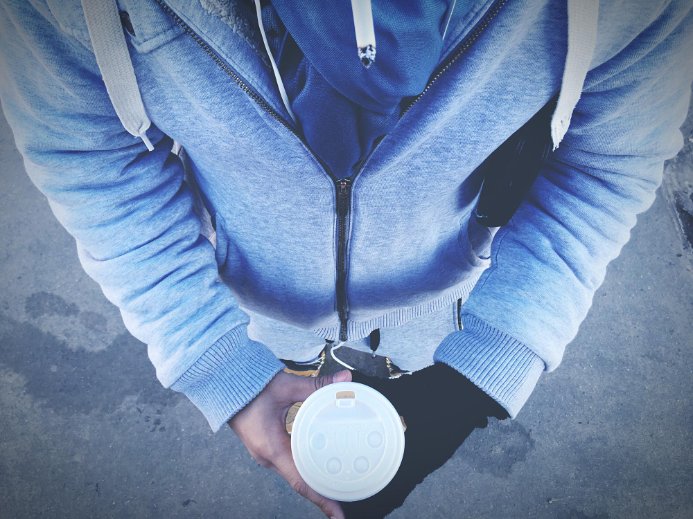
Which brand makes the best fleece? The answer depends on what you value most – performance, sustainability, price, or style. Here’s how the major players stack up:
Patagonia
Price Range: $99-$179
Known For: Sustainability, durability, quality construction
Patagonia pioneered modern fleece in the 1980s and remains the gold standard. Their fleece uses recycled materials, features excellent construction, and comes with a lifetime repair warranty. The Better Sweater line is a customer favorite for its sweater-like appearance and durability. You’re paying a premium, but you get a garment that will last 10+ years.
Best For: Buyers who prioritize sustainability and are willing to pay for quality
The North Face
Price Range: $49-$149
Known For: Technical performance, wide range of styles
The North Face offers fleece options from budget-friendly basics to technical mountaineering gear. Their Denali jacket has been an icon since 1989. They’ve increased their use of recycled materials in recent years, though they’re not as far along as Patagonia. Quality is consistently good across their range.
Best For: People who want reliable performance without paying Patagonia prices
Columbia
Price Range: $30-$90
Known For: Value, accessibility, family-friendly options
Columbia makes fleece accessible to everyone with competitive prices and frequent sales. While not as durable or feature-rich as premium brands, their fleece performs well for casual use and is perfect for kids who’ll outgrow it quickly. Many styles use recycled materials.
Best For: Budget-conscious buyers, families, casual weekend warriors
Arc’teryx
Price Range: $119-$299
Known For: Technical excellence, minimalist design, premium materials
Arc’teryx represents the high end of technical fleece. Their Polartec Power Stretch and Power Grid fleeces are engineered for serious mountaineering. Construction quality is exceptional with attention to every detail. The price reflects this – you’re paying for cutting-edge materials and bomber construction.
Best For: Serious outdoor athletes who need the absolute best performance
REI Co-op (House Brand)
Price Range: $39-$99
Known For: Quality-to-price ratio, solid warranties
REI’s house brand offers excellent value with quality comparable to brands costing $20-40 more. They’ve committed to increasing recycled content and offer a generous return policy. The fit tends to run slightly larger than other brands.
Best For: Smart shoppers who want quality without brand-name markup
Polartec (Fabric Supplier)
While not a clothing brand, Polartec makes the fabric many other brands use. When you see “Polartec” on a label, you know you’re getting quality fleece. Look for these technologies:
- Polartec Classic: Traditional fleece in various weights
- Polartec Power Grid: Grid pattern for breathability
- Polartec Wind Pro: Wind-resistant fleece
- Polartec Thermal Pro: Superior warmth-to-weight ratio
| Brand | Price | Durability | Sustainability | Best For |
|---|---|---|---|---|
| Patagonia | $$$$ | Excellent | Industry Leader | Eco-conscious buyers |
| The North Face | $$-$$$ | Very Good | Good | Versatile use |
| Columbia | $-$$ | Good | Fair | Budget buyers |
| Arc’teryx | $$$$+ | Outstanding | Good | Technical users |
| REI Co-op | $$ | Very Good | Good | Value seekers |
Shopping Tip: Watch for end-of-season sales (late winter/early spring) when fleece is marked down 30-50%. Black Friday and outlet stores also offer good deals on quality brands.
Styling and Layering with Fleece

Fleece used to be purely functional outdoor wear, but it’s evolved into a versatile wardrobe staple that works for everything from mountain peaks to coffee shops. Here’s how to make fleece work for different situations:
The Layering System
Understanding where fleece fits in a layering system helps you stay comfortable in changing conditions:
Base Layer (Next to Skin):
Lightweight merino wool or synthetic moisture-wicking top and bottom. This manages sweat and provides initial warmth.
Mid Layer (Insulation):
This is where fleece shines. It traps warm air and continues managing moisture from the base layer.
Outer Layer (Weather Protection):
Waterproof/windproof shell protects you from elements while allowing moisture to escape.
For a deeper look at layering strategies, check out REI’s expert guide to layering basics which covers how fleece fits into different outdoor scenarios.
For moderate cold (0-10°C/32-50°F): Base layer + fleece mid-layer
For cold conditions (-10-0°C/14-32°F): Base layer + fleece + insulated jacket
For wet cold: Base layer + fleece + waterproof shell
For very cold (-20°C/-4°F and below): Base layer + lightweight fleece + heavyweight fleece + insulated jacket
Outdoor and Active Wear Styling
Hiking/Trail Use:
- Pair a quarter-zip fleece with hiking pants and a cap
- Choose earth tones or muted colors that hide dirt
- Add a waterproof shell in your pack for weather changes
- Opt for fleece with chest pockets for trail maps and snacks
Winter Running:
- Microfleece or grid fleece for maximum breathability
- Slim fit to reduce bulk
- Bright colors for visibility in low light
- Pair with running tights and a lightweight vest
Ski/Snowboard:
- Mid-weight fleece under a waterproof shell
- Look for longer back hem to prevent snow from getting in
- Skip the hood to avoid bunching under your helmet
- Choose colors that match your shell for a coordinated look
Casual Urban Style
Weekend Errands:
- Full-zip fleece over a plain tee with dark jeans and sneakers
- Sherpa fleece jacket with chinos and casual boots
- Keep colors neutral (navy, charcoal, olive) for versatility
Coffee Shop Casual:
- Slim-fit quarter-zip fleece over a collared shirt
- Pair with tapered pants and clean white sneakers
- Add a beanie or baseball cap for a relaxed vibe
Working from Home:
- Fleece pullover with joggers for maximum comfort
- Half-zip fleece that looks good on video calls
- Neutral colors work with any background
Smart Casual
Yes, you can wear fleece in slightly dressier situations:
- Structured fleece jacket (like Patagonia Better Sweater) over a button-down shirt with chinos and leather shoes
- Fleece vest layered over a long-sleeve henley with dark jeans
- Quarter-zip fleece in heathered grey or navy with a collar peeking out, worn with dress pants
- Stick to solid colors and avoid technical-looking features for a cleaner appearance
Women’s Fleece Styling
- Fitted fleece jacket with leggings and ankle boots
- Oversized fleece pullover as a dress with tall boots and belt
- Cropped fleece with high-waisted jeans and sneakers
- Fleece vest over a long-sleeve tee with a midi skirt
- Sherpa fleece jacket with mom jeans and loafers
Kids and Family Styling
For more specific children’s clothing guidance, check out our facts about fleece in kids clothing.
- Choose bright colors for visibility during outdoor play
- Full-zip styles are easier for kids to manage themselves
- Budget-friendly options make sense since kids outgrow them quickly
- Match colors across family members for coordinated photos
- Look for reinforced elbows and shoulders for active kids
Color Coordination Tips
Versatile Core Colors:
- Navy: Works with almost everything, professional appearance
- Charcoal/Grey: Neutral, hides dirt well, easy to match
- Black: Sleek and versatile but shows lint
- Olive/Forest Green: Outdoorsy feel, pairs well with earth tones
Statement Colors:
- Red or Orange: Visibility for safety, confidence, energy
- Bright Blue or Teal: Fresh, modern, stands out
- Purple: Unique choice, works well for women’s styles
Patterns: Heathered or marled fleece hides wear better than solid colors and adds visual interest without being too bold.
What NOT to Wear with Fleece
- Avoid fleece with formal wear (suits, dress shoes, business attire)
- Don’t mix multiple fleece pieces (fleece jacket + fleece pants = too much)
- Skip wearing fleece to nice restaurants or formal events
- Avoid bright patterns for professional settings
Accessories That Work with Fleece
- Beanies or knit hats for cold weather
- Scarves (wool or synthetic)
- Backpacks or messenger bags
- Canvas or leather boots
- Simple watches (smart or analog)
- Sunglasses with sporty or classic frames
Working with Fleece: DIY and Sewing Tips
If you’re interested in making your own fleece items or modifying existing pieces, fleece is actually one of the most forgiving fabrics to work with. Whether you’re a beginner or experienced sewer, these tips will help you get professional results.
Essential Tips for Sewing Fleece
Fleece has unique characteristics that require specific techniques:
- No fraying edges: Fleece doesn’t unravel, so you can leave edges raw or use simple finishes
- Stretch consideration: Most fleece has some stretch, so use a ballpoint or stretch needle
- Right side identification: The fluffier side is typically the right (outer) side
- Seam choices: Flat-fell seams or simple straight stitches work well
- No pinning needed: Use clips instead of pins to avoid leaving permanent holes
- Lower iron heat: If you must press seams, use the lowest setting with a pressing cloth
Watch this helpful video tutorial: Learn 10 practical tips and tricks for sewing with fleece, including how to choose the right needle, prevent skipped stitches, and achieve professional-looking results.
Common Fleece Projects for Beginners
- Blankets and throws: Perfect first project – just cut and hem (or leave raw)
- Scarves: No pattern needed, very forgiving
- Simple hats: Quick projects that make great gifts
- Pet beds: Use up scraps and make your furry friends happy
- Pillow covers: Easy way to add cozy textures to your home
For more detailed sewing guidance, check out our beginner’s guide to sewing and our collection of easy sewing projects.
Frequently Asked Questions
Is fleece hot or cold?
Fleece is designed for cold weather and keeps you warm. It traps warm air close to your body while allowing moisture to escape. In warm or hot weather, fleece will make you uncomfortably hot. Think of fleece as your cold-weather companion – perfect for fall through spring in most climates, but too warm for summer unless you’re in air conditioning.
Does fleece actually keep you warm?
Yes, fleece definitely keeps you warm. The fabric’s fuzzy structure traps thousands of tiny air pockets that insulate your body. Fleece works even when damp (unlike cotton) and provides warmth comparable to wool at a fraction of the weight. The amount of warmth depends on the fleece weight – lightweight (100 GSM) provides moderate warmth, while heavyweight (300+ GSM) delivers serious insulation for very cold conditions.
Is fleece good for winter?
Fleece is excellent for winter as an insulating mid-layer. However, it’s not windproof or waterproof, so you’ll want to layer it under a shell jacket in harsh conditions. For dry, calm winter days, heavyweight fleece works great as an outer layer. Many people use a combination of fleece for insulation and a waterproof jacket for protection, creating a versatile layering system for all winter conditions.
Can fleece get wet?
Fleece can get wet, and unlike wool or cotton, it handles moisture well. The polyester fibers don’t absorb water, so wet fleece stays relatively light and continues to provide some insulation. It also dries incredibly fast – often within an hour or two of wearing it or hanging it up. However, fleece offers no water resistance, so rain soaks right through it. For wet conditions, always wear a waterproof shell over your fleece.
Do fleeces shrink in the wash?
Fleece typically doesn’t shrink when washed correctly in cold water and air dried. However, high heat can damage polyester fibers and cause some shrinkage. If you use a dryer, choose the lowest heat setting or air-dry option. Cotton fleece blends may shrink more than 100% polyester fleece, especially in the first wash. To be safe, always wash fleece in cold water and air dry it.
Are fleeces warmer than hoodies?
Fleece jackets are generally warmer than standard cotton hoodies because fleece is specifically designed for insulation. A fleece jacket traps more air and wicks moisture better than cotton. However, fleece hoodies (hooded fleece jackets) combine the warmth of fleece with hood coverage, making them warmer than regular fleece jackets. If your “hoodie” is actually made of fleece material rather than cotton, then it’s just as warm as any other fleece garment of the same weight.
Is fleece thick or thin?
Fleece comes in different thicknesses ranging from thin to thick. Microfleece (100-200 GSM) is quite thin and lightweight, perfect for layering. Mid-weight polar fleece (200-300 GSM) has moderate thickness – thick enough to provide good warmth but not bulky. Heavyweight fleece (300+ GSM) is noticeably thick and provides maximum insulation. When shopping, check the GSM rating or look for terms like “lightweight,” “mid-weight,” or “heavyweight” to know what you’re getting.
What does fleece feel like?
Fleece feels soft, fuzzy, and plush – almost like petting a very short-haired animal. It has a warm, cozy texture that’s smooth against your skin without being slippery. Unlike wool, which can be scratchy, fleece is gentle and comfortable even against bare skin. The inside of fleece is often brushed to create that characteristic fuzzy texture, while the outside may be smoother depending on the style. Most people describe fleece as one of the most comfortable fabrics to wear.
How long does fleece last?
Quality fleece can last 5-10 years or more with proper care. The lifespan depends on how often you wear it, how you care for it, and the original quality. Budget fleece might show wear after 2-3 years of regular use, while premium brands like Patagonia or Arc’teryx can last a decade or longer. The fabric itself is very durable, but areas of friction (under backpack straps, elbows) may wear first. Proper washing, avoiding high heat, and treating pills early all extend fleece’s life.
What is the closest fabric to fleece?
Sherpa fabric is probably the closest to fleece – it’s essentially a type of fleece with a more textured, wool-like appearance. Beyond that, Polartec and other technical synthetic insulating fabrics are in the same family. Wool is fleece’s natural equivalent in terms of purpose (warmth and insulation), though it feels and performs differently. Cotton fleece (French Terry) offers a similar cozy feel but without the same technical performance. For warmth and weight, Primaloft and other synthetic insulations are similar, though they’re used more in puffers than stand-alone jackets.
Is fleece good for sensitive skin?
Fleece is generally good for sensitive skin because it’s soft and doesn’t have the scratchy texture of wool. However, some people with very sensitive skin may react to the synthetic fibers, dyes, or chemical treatments used in fleece production. If you have sensitive skin, look for high-quality fleece without harsh chemicals, wash it before first wear to remove any manufacturing residues, and consider wearing a thin layer underneath. Organic cotton fleece is another option that’s gentler for reactive skin.
What weather do you wear a fleece in?
Wear fleece in cool to cold weather, typically when temperatures are between -10°C to 15°C (14°F to 59°F). Lightweight fleece works well in fall and spring weather or as a layer in winter. Mid-weight fleece is perfect for cold days when you’re active or as a mid-layer in very cold conditions. Heavyweight fleece handles very cold weather when you’re not generating much body heat. Avoid wearing fleece in warm or hot weather (above 20°C/68°F) as it will make you uncomfortably hot.
Is fleece different than wool?
Yes, fleece and wool are very different materials. “Fleece” as a fabric term refers to synthetic polyester fabric, though the word originally meant sheep’s wool coat. Synthetic fleece is man-made from plastic, while wool is a natural fiber from animals. Fleece is lighter, dries faster, costs less, and is easier to care for. Wool is heavier, absorbs moisture, resists odors better, and is biodegradable. Both provide good insulation, but they achieve it in different ways and have distinct advantages and disadvantages.
Conclusion
After exploring everything about fleece fabric, let’s bring it all together to help you make the best decision for your needs.
Key Takeaways
Fleece delivers exceptional value as a warm, lightweight, easy-care fabric that works for outdoor adventures and everyday life. Whether you’re hiking mountains, running errands, or lounging at home, there’s a fleece option that fits your needs.
Weight matters more than you might think. A 100 GSM microfleece works completely differently than a 300+ GSM heavyweight. Match the weight to your activity level and weather conditions. When in doubt, mid-weight polar fleece (200-300 GSM) offers the best versatility for most people.
Layering is key to getting the most from fleece. It’s not designed to be your only layer in harsh weather – pair it with appropriate base layers and shells to build a system that adapts to changing conditions. Think of fleece as your insulation layer, not your weather protection layer.
Environmental impact is real, but manageable. Fleece sheds microplastics, which is a genuine concern. However, you can minimize this impact by choosing quality over quantity, using a microfiber-catching device when washing, washing less frequently, and keeping garments in use longer. Recycled polyester options offer a better environmental profile than virgin polyester while performing identically.
Quality varies significantly between price points. Budget fleece ($20-40) works for occasional use, but if you wear fleece regularly, investing in mid-range to premium options ($50-150) pays off in durability, features, and longevity. A $100 fleece that lasts 10 years is cheaper per wear than a $30 one that lasts 2 years.
Final Recommendations
For Outdoor Enthusiasts: Invest in at least two fleece pieces – a lightweight option for high-output activities and a mid-weight for general use. Look for features like reinforced shoulders, helmet-compatible hoods, and zippered pockets. Patagonia, Arc’teryx, or The North Face offer the durability you need.
For Casual Users: A single mid-weight polar fleece jacket or quarter-zip handles most situations. Choose a versatile color like navy or charcoal that goes with everything. Columbia, REI Co-op, or The North Face offer good value without unnecessary technical features you won’t use.
For Families: Start kids with budget-friendly options since they’ll outgrow them quickly. Adults should invest more in quality pieces that last. Coordinate colors if you want a put-together look for family photos. Watch for sales to outfit everyone affordably.
For the Eco-Conscious: Choose recycled polyester fleece from brands with strong environmental commitments like Patagonia. Use a Guppyfriend bag when washing, and commit to keeping your fleece in use for many years. Consider wool as a natural alternative, accepting the trade-offs in care and cost.
For Budget-Conscious Shoppers: Wait for sales (especially end-of-season), shop outlet stores, or look at house brands like REI Co-op. A $50 quality fleece on sale beats a $30 cheap option every time. Treat it well, and it’ll last for years.
Your Next Steps
Now that you understand fleece fabric inside and out:
- Assess your needs – what activities will you use fleece for?
- Determine the right weight for your climate and use
- Set a budget that balances quality with affordability
- Choose features that matter to you (pockets, hood, fit)
- Consider environmental impact in your decision
- Try on different brands to find the best fit for your body
- Care for your fleece properly to maximize its lifespan
Fleece has earned its place as one of the most popular fabrics for good reason. It performs well, costs less than alternatives, and makes cold-weather activities more comfortable. While it’s not perfect (especially regarding microplastic pollution), informed choices and proper care minimize the downsides while maximizing the benefits.
Whether you’re gearing up for a mountain expedition or just want something cozy for weekend walks, fleece delivers warmth, comfort, and versatility that’s hard to beat. Choose wisely, care for it well, and your fleece will serve you faithfully for years to come.
Ready to explore more fabrics? Check out our guides on natural vs synthetic fabrics or learn about common fabric types to expand your textile knowledge.

